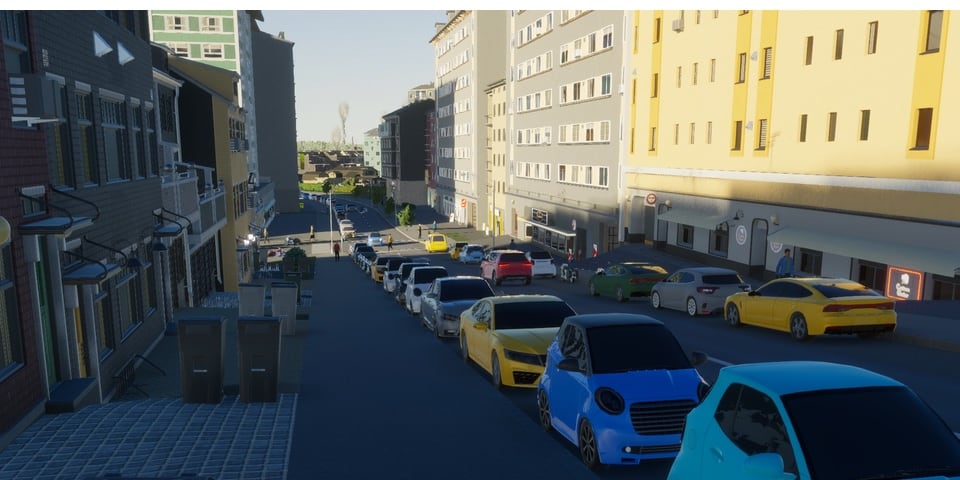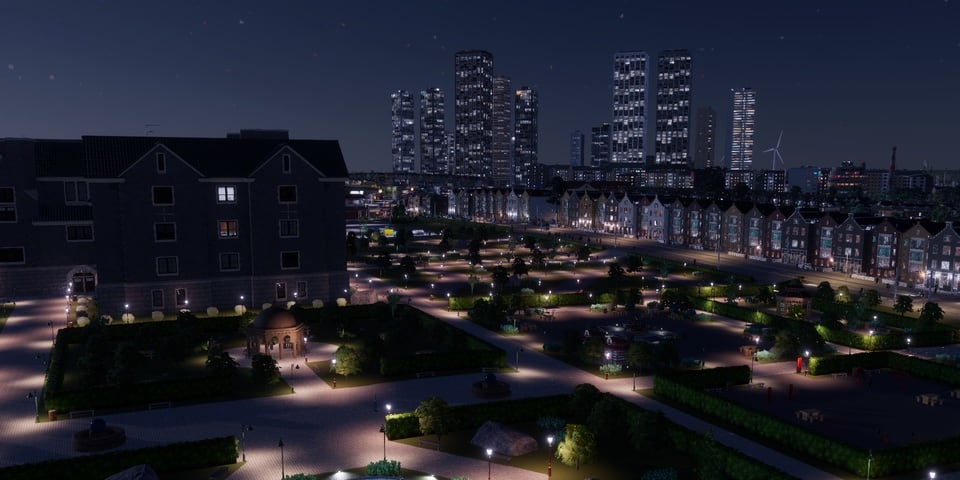While it’s less common to see these days, there’s countless instances throughout history of people simply deciding to up sticks and not just move to another town or city, but actually go and found a brand new one. It might well be time to do exactly that for city builder fans, leaving of a game that’s eight years old, and jumping across to the shiny new development and greener pastures of Cities: Skylines 2. It’s a sequel that comes with a lot of mod cons built in from the start, but will old hands miss some of the creature comforts of DLC left behind?
Updated 24/10: This is now our full, scored review of Cities: Skylines 2.
The fear whenever a long-running game with countless expansions is superseded by a sequel is that the developers are going to take back all of their toys and force you to buy them all over again. That’s absolutely not the case with Cities: Skylines 2. Compared to the original’s base game, Skylines 2 comes with half a dozen expansion-worth of gameplay features built in on day one. There’s the night and day cycle, there’s seasons, there’s broad public transport options, there’s natural disasters, and more. Yes, there’s plenty of areas where they can expand and refine, ideas from DLC that they can revisit, but the base game already feels like a complete, well-rounded experience.
However, Colossal Order has hit the reset button in other places, and expanded in others with new ideas. One of the key overhauls has come with the progression system. Before this was just a straight up progression as your village grew to a town and then a bustling city, each growth point marking a population milestone. Population still matters here, but it’s now part of a broader experience system that grows alongside their happiness, and actively improving the city infrastructure, all netting you varying amounts of XP. As you hit a milestone, you might then unlock certain categories of zoning or new types of services, but anything beyond the absolute basics (so a larger hospital or trams and metros) has to be picked from a tech tree of sorts. It’s a nice game-y way of handling things, letting you nudge the flow of unlocks, even if the overarching progress will largely be the same.

And that progression has been smoothed out significantly by a couple of changes to the economy. As your burgeoning city grows, you’re handed a generous government subsidy to help reduce the shortfall of taxes and revenue versus the cost of providing services. Combine that with the lump sums you gain from each milestone, and you might not need to touch the loans system at all. Then there’s the ability to tie in with a broader economy. There’s neighbouring named cities that you can hook your transport up to, but you can also send utilities their way, selling surplus electricity and water, and even dealing with their waste for profit. Alongside pushing your industry to make specific use of natural resources, you can significantly balance the books, if not make yourself completely self-sufficient. From chicken farms to oil drilling, they’re bespoke building with fully customised work spaces, when compared to simply zoning roadside blocks for industry.
Speaking of buildings, almost all of the service buildings that you can construct now have the ability to be expanded and upgraded. Schools can have additional wings added to increase pupil capacity, playgrounds and special needs centres to improve their well being, police stations can gain extra prison cells, cemeteries have tombs added for the rich and influential. It’s something that allows you to build a bit taller and not have to overstuff your city with service buildings as the population increases per square kilometre. It also adds a little visual variety, but early on you do need to be aware of the monthly upkeep that each one adds, as they’re then a constant drain on your coffers.

As robust as the road-laying options in Cities: Skylines already were, Cities: Skylines 2 overhauls them in some significant ways. There’s now a wealth of overlay information as you’re laying roads, tracks and paths, showing the angle of incidence, curvature, elevation change and so much more. It’s helpful if you’re trying to very precisely engineer the perfect road, the smoothest bend in a train track, the most aesthetically pleasing tunnel, and all the other things it’s easy to agonise over for tens of minutes at a time. At the same time, it’s still delightfully easy to just stamp down some roads quickly, and let the road snapping do its thing – this can be a bit too finicky with too many snapping points, though you can disable these guides quickly.
The types of road your laying have been reconsidered too. Standard roads come with parking, while grassy verges, trees, tram tracks, bus stops and and other adornments are optional additions later on. You can quite easily upgrade roads too, swapping to fully pedestrianised streets, to asymmetrical three-lane roads, or shifting to wider roads and highways, conveniently snapping on one side or the other so you can preserve as much of your zoning and existing buildings while upgrading.

Cities: Skylines 2 promises greater AI car smarts to deal with congestion and find alternative routes when there’s traffic jams or road accidents, and by and large it does seem to do the trick. Traffic jams can still happily form through busy intersections or when there’s a car crash being dealt with, but the only time I had a real log-jam was when my road layout wasn’t quite gelling with the multi-lane roundabout – something I took a while to fix and solved.
Oh, and through all of this electrical wiring and fresh and waste water pipes are now built into all types of local roads, meaning you just need to deal with small and incidental connections for power sources themselves and bridges. It’s a great tweak.
With roads stamped out, zoning falls into the same residential, commercial and industrial categories as before, and there’s often a familiar feel compared to the first game. Cities: Skylines 2 comes with two sets of building themes – North American and European – and I’m absolutely in love with how the latter option makes the game look. Between the standard detached housing and blocks of flats, you can now zone for terraced (row) housing for medium density, there’s differentiation between apartment blocks and low rent housing akin to council flats, but best of all is the new combined commercial and residential with shops on the ground floor and a few stories of flats above. This one addition alone adds so much to the style of your city.

So much of Cities: Skylines 2 is fantastic, that the handful of flaws stick out. Firstly there’s performance issues that Colossal Order have acknowledged prior to launch and are aiming to address shortly after launch. It’s been eight years since the first game came out, and so hardware requirements have taken an understandably big leap forward, but they are having to address certain graphics settings that are draining high-end PCs.
Personally, my PC is in a bit of a no man’s land, with a Ryzen 5900X CPU plenty above the recommended system spec, but my Radeon Vega 56 GPU leaning toward the lower end these days. Playing at 1080p and with Low settings (but FSR upscaling turned off), with a large city spanning several distinct regions, performance is generally in the 20-35FPS range depending on what I’m doing – fast panning and shifting to closer views could drop it into the high teens. Maybe I’ve been conditioned by gaming on under-specced PCs and ported Mac games in the early 2000s, but for a city builder, this is a liveable experience to me.
Beyond performance and visuals, there’s just a few snagging points with the game’s UI and some elements of gameplay. Laying out a tram system, it’s tricky to really see what roads have tram tracks laid within them, and the only way to remove the tracks seems to be to remove the road entirely. It’s also a bit barmy that the only commuter train station option forces you to have a massive station with two extra redundant stretches of track, when the vast majority of train stations in the world are simply a pair of platforms – this enables that modular expansion, but in this case it’s a bit much. And the XP progression system does run out of steam by the time you reach the “City” tiers, and got yourself a steady income to fund future expansions.

I’m certainly keen to see how Colossal Order is able to grow and expand this game. With a good chunk of core functionality from the original’s early DLC packs already covered, I’m eager to see them really dig further into industrial management and production lines – as they previously did with the Industries DLC – to hopefully fill out some more niche building types. Mod support will also help in that regard.
Speaking of which, mods aren’t in the game at launch, and there’s been a degree of controversy surrounding the late announcement that they will be using Paradox’s homegrown modding system instead of Steam Workshop. There’s pros and cons to each, with Steam Workshop a well-worn mod platform for PC gamers, but Paradox Mods allowing for cross-platform modding support to the PS5 and Xbox Series X|S versions coming next year.



